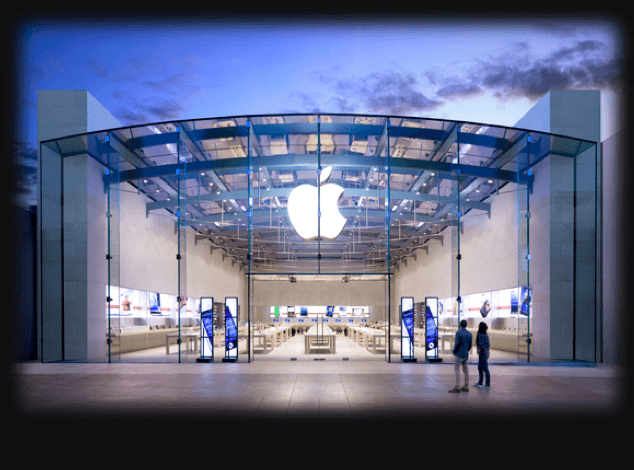Apple, Inc. (AAPL; NASDAQ) continues to ride high on record sales and revenues after a blisteringly strong quarterly earnings report last month. The company managed to boost sales with their latest iPhone offering and have recently released or are planning to release several new product lines. The company’s recent reintroduction of its dividend program has also been a stable (if not otherworldly) and sustainable success. However, there is some concern that revenue growth is slowing, and that some of the company’s products have not performed as well. A major problem is Apple’s overreliance on earnings from iPhones, and despite new successes, no other product in the company’s portfolio has come close to matching its success. Some have suggested that Apple should refocus its business model on services, but the company faces stiff challenges in that area. Apple must find a way to balance its earnings to ensure continued success even if iPhone sales trail off.
A Picture of Apple
Apple is undoubtedly one of the top technology companies in the world. Despite fierce challenges and competition from companies such as Samsung and LG, Apple is comfortably in the lead in the category that matters most—profit. In the third quarter, Apple’s iPhone (despite not selling the most units) took an astounding 94% of profits for smartphone sales, a number made more impressive by the growth from the previous quarter’s 85%.
On a company level, robust iPhone sales have substantially contributed to Apple’s historically great third quarter results. The company reported 22% revenue growth year over year (up to $51.501 billion), and an increase in profits from $8.467 to $11.124 billion (31% expansion). The numbers led to a fantastic close for the company’s fiscal 2015, with yearly revenues also up by 28%. Much of this came on the back of the iPhone, but Apple also reported record sales of Macs and new products also contributed to the revenue growth.
Despite these great numbers, however, Apple saw some real disappointments for the quarter, and some things that should give the company pause. First, iPad sales, which are already far from their peak sales numbers, continue to see shrinking sales. After a 5% drop in revenues from iPad sales in 2014, fiscal 2015 saw Apple lose a whopping 23% in revenues. Sales of Macs, despite displaying a record number of sales, also showed slowed growth in 2015 (only 6% growth compared to 2014’s 12% increase). The other bright spot for the company was growth in revenues from other products (which include new details of sales from the Apple watch). As of now, Apple still draws over 60% of all its revenues from iPhone sales, which creates a major vulnerability for future earnings.
Can (and Should) Apple Diversify?
Apple’s heavy reliance on iPhones for revenues has so far paid off. The company has had wild success with yearly releases of upgraded versions, and, as stated above, still draws the lion’s share of industry profits. The company has had great success becoming the leader for top tier mobile electronics. However, weakening iPad sales, combined with relatively flat growth amongst all other product lines, leads to some concern about the company’s ability to withstand a fluctuation in iPhone earnings.
IPads continue to flounder as sales continue to tumble from peak sales of 26 million units in the first quarter of 2014, with new versions unable to reverse the trend. Apple’s most recent offering, the iPad Pro, has not been as well received as previous iterations. Though the company has billed it as a virtual replacement for a laptop, many have questioned its true target and function, but it remains too early to tell whether the product will truly take off.
The company’s Apple watch has also not had the booming success Apple hoped it would have, but it is still early in its product life cycle, and with the company soon to announce a second generation, the jury is also out on how big of an impact the watch will have on the revenue distribution.
Some have suggested that Apple should refocus its business model towards a subscription-based hybrid. The company could offer digital services (such as its already existing Apple Pay, Apple Music, iCloud, etc.) as well as a more subscription-like model even for its hardware. While this is definitely an interesting possibility, Apple could face competition on several fronts in that department.
In the media distribution sector, Apple would have to compete with the likes of Netflix, Hulu, and Amazon Prime, while it is already facing off against Spotify and Google Play in the music sector. It also lags behind Google’s cloud services operation and would need to heavily invest in upgrading its offering to compete.
A bright spot and possible big earner for the company is its Apple Pay service, which has been a strong competitor with other e-payment systems (such as PayPal and Google’s pay service). If Apple can succeed in establishing itself, could become an interesting and high-potential revenue source based on industry trends and the wide amount of market saturation with its actual products which are perfect platforms for e-payments. However, Apple must prove that it can find a way to maximize earnings despite having to split revenues with payment processors and banks.
Is Apple Worth it?
At its current valuation and price, Apple is in a great position, as it is heavily undervalued and is trading at less than 13 times earnings. Even with a slowing rate of growth, the company is in a good position to continue maximizing returns for investments, as well as continuing to issue dividends to shareholders. At present, the dividend yield stands at 1.77% which while not the most attractive in the market, is likely to remain stable amid the massive inflows of cash the company experiences every year. Cash flows might be a concern and while the upcoming holiday sales quarter is likely to be beneficial to Apple’s bottom line, if this trend prevails over the long-term it could be a negative signal going forward. Nevertheless, the holidays in particular are Apple’s best performing months, which could see shares run back towards highs at $134.54.
Despite a long-term risk if the company continues or increases their dependence on the iPhone, Apple is still a good bet for investors seeking a stable and great dividend stock at a low entry price.
Tradersdna is a leading digital and social media platform for traders and investors. Tradersdna offers premiere resources for trading and investing education, digital resources for personal finance, market analysis and free trading guides. More about TradersDNA Features: What Does It Take to Become an Aggressive Trader? | Everything You Need to Know About White Label Trading Software | Advantages of Automated Forex Trading


































